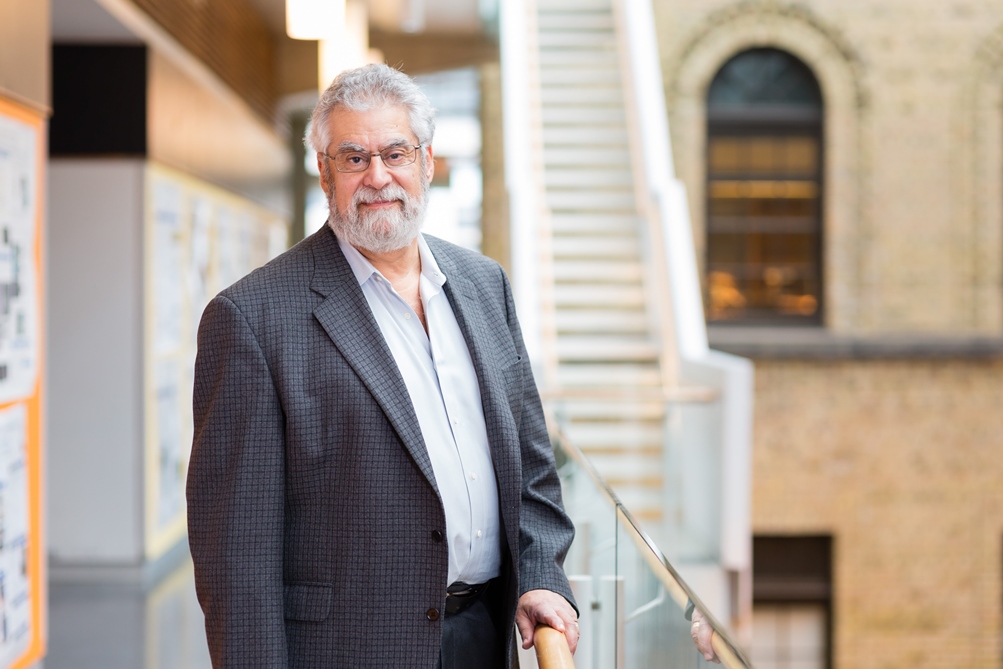BBDC Researcher’s Engineering Accomplishments Celebrated
September 11, 2020
By Krista Lamb

(photo by Neil Ta)
In February, BBDC researcher Dr. Michael Sefton was inducted into the National Academy of Engineering, one of the highest honours in his field—and of particular significance for a Canadian biomedical engineer.
Sefton, a Professor at the University of Toronto and the Executive Director at Medicine By Design, has had an impressive career, having been honoured with the Order of Canada in 2017 and an induction into the National Academy of Medicine in 2014. However, this honour was especially sweet. “This is a recognition that the track I was on was the right track,” he says. “That the idea of integrating engineering with biological approaches to address diabetes was something that people thought warranted recognition.”
Sefton’s interest in diabetes research began when he attended a talk by Dr. Michael Albisser in the mid-1970s. Sefton was a new faculty member at the University of Toronto and Albisser and his team at The Hospital for Sick Children were working on one of the initial prototypes for the artificial pancreas. “It was huge,” Sefton recalls. “It took up half of a patient’s room and consisted of a machine that would measure glucose, a computer with an appropriate algorithm and an insulin pump that would pump insulin into the patient in response to the glucose level.” It worked well, in that it did what it was intended to do, but it wasn’t exactly practical for widespread use.
Listening to the talk, Sefton began to wonder if his experience with the controlled release of drugs could provide a solution. “I thought, why can’t I use hydrogels, the materials I work on, to control the release of insulin and to do variable rate delivery to be able to deliver insulin at low levels overnight and then associated with each meal?” he recalls.
So, Sefton began working with early versions of insulin pumps—very rudimentary tools compared to what patients with type 1 diabetes use today—looking into ways to better automate delivery. Along the way, he became increasingly interested in the encapsulation of beta cells to safely and effectively replace the cells that are damaged or destroyed in those with type 1 diabetes. Now, that is the primary area of interest for his work with the disease.
“The encapsulation idea was to address the problem that if we transplant islets we need to control the immune response. That’s hard to do with patients who have diabetes,” he explains. “Can we hide the islets from the body through an immune barrier?”
Sefton’s team began looking at options that would implant the encapsulated cells under the skin, “We focused on trying to vascularize that interface,” he explains, hoping that by developing a way to nurture and support the cells they could ensure that the implant would adapt to the body.
The Canadian contribution to islet transplantation has been significant—the very first successful islet transplants were done in Alberta using the gold standard Edmonton Protocol—and to this day Canadian researchers like Drs. James Shapiro, Timothy Kieffer and Cristina Nostro are leading the way in developing stem-cell-derived beta cells and encapsulation devices to keep those cells safe inside the body. Sefton’s lab has made an impressive contribution to this field.
“In science, everybody has 10 percent of the story,” he says, noting that each research program brings a new piece to the very large puzzle. “There are parts of the story, whether it’s membranes, whether it’s insulin production, whether it’s trying to build systems, which are where an engineer naturally comes to it. A complete solution won’t happen without some engineering somewhere in the system. And it can be different kinds of engineering in different parts of story. It’s hard to imagine having a glucose sensing and pump system without lots of engineering involved. It’s similarly going to be hard to imagine a stem cell driven system without a means of delivering those cells. The word for this is convergence, and various fields are converging. And that involves integration of life sciences and engineering.”
Moving forward, Sefton’s lab will continue to work on delivering insulin-producing cells under the skin and ways to modulate the immune response. They are determined to find the key tools that will allow them to allow the immune system to tolerate these foreign cells.
